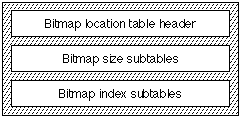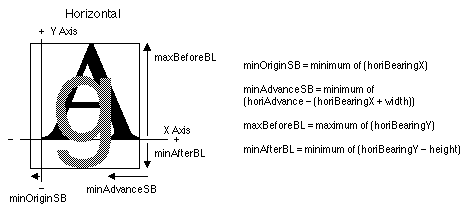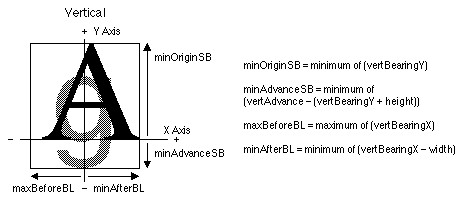'bloc' tableThe bitmap location table(tag name: 'bloc') provides information about the availability of bitmaps at requested
point sizes. If a bitmap is included in the font, it also tells
where the data is located in the bitmap data table. The bitmap location and bitmap data tables support various formats.
While the format theoretically permits some features like sparse glyph sets, implementations may not support these features. It's usually best to check with the software provider to see how much of this (or, indeed, any) table is supported.
The overall structure of the bitmap location table is shown in the following figure:

The header for the bitmap location table is shown in the following table:
| Type | Name | Description |
|---|---|---|
| fixed | version | Version number of the bitmap location table (0x00020000 for the initial version). |
| uint32 | numSizes | The number of bitmapSizeTables in this table. |
| variable | bitmapSizeTable[numSizes] | Subtables describing the general characteristics of the bitmapped glyphs in this font. Also contains the indexSubTableArrayOffset. |
Each bitmapSizeTable subtable provides information about the global characteristics
of a particular set of bitmaps.
Note: The sizes must be sorted in ascending order.
The format for the bitmapSizeTable (which refers to the indexSubTableArray, which in turn refers to an indexSubTable) is shown in the following table:
| Type | Name | Description |
|---|---|---|
| uint32 | indexSubTableArrayOffset | Offset to corresponding index subtable array from the beginning of the 'bloc'. |
| uint32 | indexTableSize | Length of corresponding index subtables and array |
| uint32 | numberOfIndexSubTables | Number of index subtables (there is one for each range or format change). |
| uint32 | colorRef | Set to 0, ignore for now. |
| sbitLineMetrics | hori | Horizontal line metrics. |
| sbitLineMetrics | vert | Vertical line metrics. |
| uint16 | startGlyphIndex | Lowest glyph index for this size. |
| uint16 | endGlyphIndex | Highest glyph index for this size. |
| uint8 | ppemX | Target horizontal ppem. |
| uint8 | ppemY | Target vertical ppem. |
| uint8 | bitDepth | Bit depth of the strike. |
| uint8 | flags | See table below; first two bits are for orientation, vertical or horizontal. |
The indexSubTableArrayOffset is the offset from the beginning of the 'bloc' table to the indexSubTableArray. Each strike has one of these
arrays to support various formats and discontiguous ranges of
bitmaps. This array is described in more detail below.
The indexTableSize is the total number of bytes in the index subtable array and
the associated index tables.
The numberOfIndexSubTables is a count of the index tables for this strike.
The colorRef is put in for future enhancements that are not currently supported
by the TrueType scaler, but these fields are already in use by
other platforms (e.g. Newton), and are defined as follows.
bitDepth = 1 and colorRef = 0, then the glyphs are 1 bit per pixel. (Quickdraw GX fonts
should only use this set of values).
bitDepth = n and colorRef = 0, then the glyphs are black-and-white, but pre-expanded for
drawing into that particular bit depth (e.g. a 2, 4, 8, 16, 24-bit
screen).
bitDepth = n and colorRef = m, then these are complex multi-bit glyphs, and the data pointed
to by the colorRef determines what they mean. These could be color fonts, anti-aliased
fonts, grey levels, or anything else. If the colorRef is anything but zero, the sfnt must have a 'colr' table. The colorRef is used with this table to get more information on the sbit.
A separate table is used (instead of an offset in the 'bloc' table) since a color table has implications outside of the scope
of sbits.
To recap, the bitDepth is what it says, the depth of this strike. This is useful for
greyscale or color fonts. To maintain compatibility with scalers
that will read sbit data, the following table shows how the colorRef and bitDepth values are used:
| bitDepth | colorRef | Meaning |
|---|---|---|
| 1 | 0 | Standard 1-bit font. |
| n | 0 | Multi-bit black and white font. |
| n | m | Color, grayscale, anti-aliased, etc. |
The horizontal and vertical line metrics follow. These contain
the ascender, descender and maximum pixel width information. Additionally,
the caret information used by Quickdraw GX Line Layout is included.
The slope is used to determine the angle at which the caret is
to be drawn and the offset is how many pixels (plus or minus)
to move the caret. This is a signed char value (and not a fixed) since we are dealing with integer metrics. The minOriginSB, minAdvanceSB, maxBeforeBL, and minAfterBL values are described below. These values are primarily used by
scalers that may need to pre-allocate memory and/or need more
metric information to position glyphs. These numbers are not used
by the sbit scaler on the Macintosh, but may be used on other
platforms, such as Newton.
The global metric information about the strike is kept in a sbitLineMetrics record, one for the horizontal metrics and one for the vertical.
The format of the sbitLineMetrics record is shown in the following table:
| Type | Name | Description |
|---|---|---|
| int8 | ascender | This is the spacing of the line before the baseline. |
| int8 | descender | This is the spacing of the line after the baseline. |
| uint8 | widthMax | Maximum pixel width of glyphs in strike. (Not used by Quickdraw GX, may be used by other platforms.) |
| int8 | caretSlopeNumerator | Rise of the caret slope, typically set to 1 for non-italic fonts. |
| int8 | caretSlopeDenominator | Run of the caret slope, typically set to 0 for non-italic fonts. |
| int8 | caretOffset | Offset in pixels to move the caret for proper positioning. |
| int8 | minOriginSB | Minimum of horiBearingX (or vertBearingY for a vertical font). |
| int8 | minAdvanceSB | Minimum of horiAdvance - horiBearingX + width (or vertAdvance - vertBearingY + height for a vertical font). (Not used by Quickdraw GX, may be used by other platforms) |
| int8 | maxBeforeBL | Maximum of horiBearingY (or vertBearingY for a vertical font). (Not used by Quickdraw GX, may be used by other platforms) |
| int8 | minAfterBL | Minimum of horiBearingY - height (or vertBearingX - width for a vertical font). (Not used by Quickdraw GX, may be used by other platforms) |
| int16 | pad | Padding to make long aligned. |
An example of the minOriginSB, minAdvanceSB, maxBeforeBL, and minAfterBL values for horizontal text is given in the following figure.
These values are calculated from the min and max values of the
glyph metrics, which come from the bitmap data table.

The same fields used in vertical text are shown in Figure 20-3.

Most of the formats have metric information in either bigGlyphMetrics or smallGlyphMetrics. The big metrics contain both horizontal and vertical metrics
whereas the small metrics only hold metrics for one direction.
The bitmapSizeTable.flag field indicates if the small metrics are horizontal or vertical
for a given strike (see the following table for the flag values). The scaler makes up fake metrics for
the orientation that is not included.
| Mask | Name | Meaning |
|---|---|---|
| 0x01 | flgHorizontal | Small metrics are horizontal for the given strike. |
| 0x02 | flgVertical | Small metrics are vertical for the given strike. |
The index subtable array contains the glyph ranges and offsets
to indexes within this table. After determining the strike to
use the scaler goes to this array to search for the index that
contains the glyph number. When the index is found it will be
an offset to an index subtable. The index subtable array is located
via the indexSubTableArrayOffset in the corresponding bitmapSizeTable. The first indexSubTableArray is after the last bitmapSizeTable entry. Then the index subtables for the strike follow. The next
indexSubTableArray (if more than one strike exists) and its index subtables are
next. Each of the indexes must start on a long boundary; when
using format 3, sometimes an extra uint16 is needed in the offset array for padding. This table then continues
with this array and indexes for each strike.
The format of the indexSubTableArray is shown in the following table:
| Type | Name | Description |
|---|---|---|
| uint16 | firstGlyphIndex | Index of first glyph in this range. |
| uint16 | lastGlyphIndex | Index of last glyph in this range. |
| uint32 | additionalOffsetToIndexSubtable | Used to reach the indexSubTable; add to indexSubTableArrayOffset to get the offset from the beginning of the 'bloc' table. |
Finally we get to the index subtable. Currently there are two
formats of indexes: one for proportional data and one for monospaced
data. Whether the data is fixed size or variable size determines
which index to use. Note: the format of the 'bdat' data can be in any format. It is not determined by the index
format. The index tells us where the information for a particular
glyph starts in the 'bdat' and how large the data is. The size of the data for the glyph
is the difference of offsetArray[glyphIndex+1] - offsetArray[glyphIndex]. The format 1 index subtable is the proportional format index.
This will be used for most roman fonts and the first 200 or so
glyphs in large Chinese, Japanese or Korean fonts. The imageFormat tells us what kind of data is in the bitmap data table.
Each index subtable provides information about the location of
the actual bitmap data for each glyph in the font. The indexSubTables
that actually contain the location of the glyph data in the 'bdat' table come in three formats. Format 1 is for proportionally spaced
glyphs. Format 2 is for mono-spaced glyphs. Format 3 is also for
proporionally spaced glyphs but uses an array of uint16 instead
of uint32 and is thus a compressed form of format one. Each of
the indexSubTables have an indexSubHeader. The format of the index
subheader is shown in the following table:
| Type | Name | Description |
|---|---|---|
| uint16 | indexFormat | Format number (1 is proportional with 4-byte offset deltas, 2 is monospaced, and 3 is proportional with 2-byte offset deltas). |
| uint16 | imageFormat | Code for the kind of image data. See the description of the 'bdat' table for the interpretation of this value. |
| uint32 | imageDataOffset | Offset to the base of the image data for this index subtable. |
In format 1 and format 3, data are stored contiguously so that the length of the data for any glyph is given by subtracting the location for the glyph from the location of the next glyph. If the length is zero, then no bitmap is available for that glyph in that bitmap set. The Format 1 bitmap index subtable is shown in the following table:
| Type | Name | Description |
|---|---|---|
| indexSubHeader | header | Header info as described above. |
| uint32 | offsetArray[] | offsetArray[glyphIndex] + imageDataOffset = start of the bitmap data for the glyph. |
The format 3 index subtable is also a proportional format index. It is just like format 1 except the offsets are shorts instead of longs.
The Format 3 bitmap index subtable is shown in the following table:
| Type | Name | Description |
|---|---|---|
| indexSubHeader | header | Header info as described above. |
| uint16 | offsetArray[] | offsetArray[glyphIndex] + imageDataOffset = start of the bitmap data for the glyph. |
For monospaced fonts the metrics are the same and only the bitmap
changes. For those we use format 2 index subtables. The metrics
are not in the bitmap data table, but rather are here in the subTable.
Only the actual bitmap data is put in the bitmap data table for
these glyphs. The data can be in various formats; byte aligned,
bit aligned, compressed, etc. The size of all the bitmap data
needed to be read in from the bitmap data table is the imageSize. The imageDataOffset is the offset into the bitmap data table for the first of this
range of glyphs. The rest of the glyphs can easily be found by
multiplying the imageSize by the difference (theDesiredGlyphIndex - firstGlyphIndexInThisRange), and then adding the result to the imageDataOffset in the header of the index header.
The Format 2 bitmap index subtable is shown in the following table:
| Type | Name | Description |
|---|---|---|
| indexSubHeader | header | Header info as described above. |
| uint32 | imageSize | All the glyphs are of the same size. May be compressed, bit-aligned, or byte-aligned. |
| bigGlyphMetrics | bigMetrics | All the glyphs share the same metrics. |
The metric information for index type 2 glyphs is of type bigGlyphMetrics, which is documented in the bitmap data table documentation.
Embedded bitmaps intended for use with Mac OS 8.5 and earlier versions of the Mac OS must contain one bitmap glyphs for every glyphs in the font. Sparse bitmaps are not allowed on the Mac OS.
The fields minOriginSB, minAdvanceSB, maxBeforeBL, and minAfterBL in the sbitLineMetrics records are not used on the Mac OS.
As Newton fonts are bitmap only, it goes without saying that embedded bitmaps intended for use with the Newton OS must contain one bitmap glyphs for every glyphs in the font. Sparse bitmaps are not allowed on the Newton OS.
The fields minOriginSB, and minAdvanceSB in the sbitLineMetrics records are not used on the Newton OS. The fields maxBeforeBL, and minAfterBL are, however, used and cannot be set to 0. As a rule of thumb,
however, they may be set to the record's ascender and descender values, respectively.
A 'bloc' table is, naturally, inextricably connected with the font's
'bdat' (bitmap data) table. If one is present, the other must be, too, and a change to one
will almost inevitably trigger a change in the other.
As a rule, most font editing tools will probably find it more convenient to read and write the two tables simultaneously rather than treat them separately.
The number of glyphs in the embedded bitmaps as indicated for
the font's individual point sizes must be equal to the number
of glyphs in the font as contained in the 'maxp' (maximum profile) table.
Fonts with bitmaps may require external fbit ("marukan") files to work properly on East Asian systems. Fbit files can be generated with TrueEdit.
It is possible to view the bitmaps and other data contained in
a TrueType font with TrueEdit. The bitmaps themselves, however, cannot be edited, although
the metric and other information contained in a 'bloc' table can be edited.
Actual editing of the bitmap glyphs in a TrueType font and their associated metrics is possible with Sbit Editor.